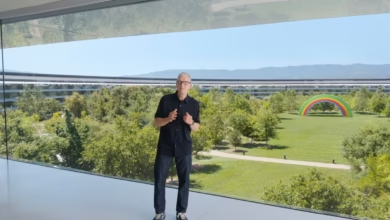Meta Just Dropped Llama 4 – Here’s Why Their New AI Brains Matter

▼ Summary
– Meta has launched Llama 4, a new family of AI models designed for various tasks, enhancing competition in the AI industry.
– Llama 4 features significant improvements in reasoning, coding capabilities, multilingual fluency, and efficiency through the “mixture of experts” architecture.
– The models are natively multimodal, processing both images and text seamlessly, with specific models like Llama 4 Scout and Maverick tailored for different performance needs.
– Meta emphasizes openness, making Llama 4 accessible to researchers, developers, and businesses, contrasting with the more proprietary approaches of competitors.
– Safety protocols, including Llama Guard, are in place to ensure responsible use, with Llama 4 available through major cloud providers and expected to enhance Meta’s apps.
NEW YORK – The artificial intelligence arena just got more crowded. Meta, the company behind Facebook and Instagram, announced the arrival of Llama 4 today, launching its latest generation of AI models designed to power everything from chatbots to complex problem-solving tools. This move intensifies the ongoing competition among tech giants racing to build the most capable and efficient AI systems.
For professionals tracking digital shifts, Llama 4 isn’t just another iteration. It represents Meta’s continued push to make powerful AI broadly available, sticking to a more open approach compared to some rivals. Let’s dive into what makes Llama 4 significant.
What’s New with Llama 4?
Meta isn’t just releasing one model, but a family designed for different tasks and power levels. The company is touting major advancements over its previous Llama versions:
- Sharper Thinking: Llama 4 models are built for improved reasoning, better handling of complex instructions, and more logical outputs.
- Coding Capabilities: A significant focus has been placed on enhancing the models’ ability to understand, write, and debug computer code.
- Multilingual Fluency: The new models promise stronger performance across a wider range of languages, expanding their potential reach.
- Efficiency Gains: Meta is using an architecture called “mixture of experts” (MoE). Imagine a team where specialists handle tasks they excel at, making the whole operation faster and less resource-intensive. Llama 4 applies this concept internally.
- Built for Sight and Text: These models are described as “natively multimodal.” This means they were designed from the ground up to process and understand both images and text seamlessly, rather than having vision capabilities bolted on later. This could lead to more sophisticated interactions involving visuals.
Two specific models announced are Llama 4 Scout and Llama 4 Maverick. Scout is positioned as highly efficient, capable of running on less powerful hardware and featuring an exceptionally large “context window” – meaning it can process and recall information from very long documents or conversations (reportedly up to 10 million tokens). Maverick is the higher-performance option, aimed at tackling more demanding tasks and positioned to compete directly with top models from OpenAI and Google. Meta also mentioned Llama 4 Behemoth, an even larger model still in training, used internally to help teach Scout and Maverick.

The Competitive Edge and Openness
Llama 4 doesn’t exist in isolation. It squares up against established players like OpenAI’s GPT series (including GPT-4o) and Google’s Gemini models. Meta claims Llama 4, particularly Maverick, performs competitively or even better than these rivals on various industry tests (benchmarks) measuring skills like coding, reasoning, and multilingual abilities.
A key part of Meta’s strategy remains its commitment to openness. While the exact terms evolve, the core idea is making these powerful models accessible to researchers, developers, and businesses, allowing them to build upon Meta’s work. This contrasts sharply with the more guarded, proprietary nature of models like GPT-4.
Safety and Getting Your Hands On It
Recognizing the potential risks of powerful AI, Meta emphasized its safety protocols. The release comes with updated tools, like Llama Guard, designed to help developers filter harmful inputs and outputs, promoting responsible use. These efforts aim to build trust and mitigate potential misuse as AI becomes more integrated into daily life.
Developers and businesses can expect access to Llama 4 through familiar channels: major cloud providers (AWS, Google Cloud, Azure), platforms like Hugging Face, and potentially direct downloads. End-users are likely to encounter Llama 4 powering improved features and AI assistants within Meta’s own apps like WhatsApp, Messenger, and Instagram in the near future.
The Bottom Line
The launch of Llama 4 underscores the relentless pace of AI development. For the tech industry, it provides a new set of powerful, relatively open tools that could spur innovation. For businesses, it offers potentially more cost-effective options for integrating advanced AI. And for everyone else, it signals the arrival of even smarter digital tools and experiences just around the corner. Meta has clearly dealt its next major hand in the high-stakes AI game.
(Inspired by TechChrunch)






